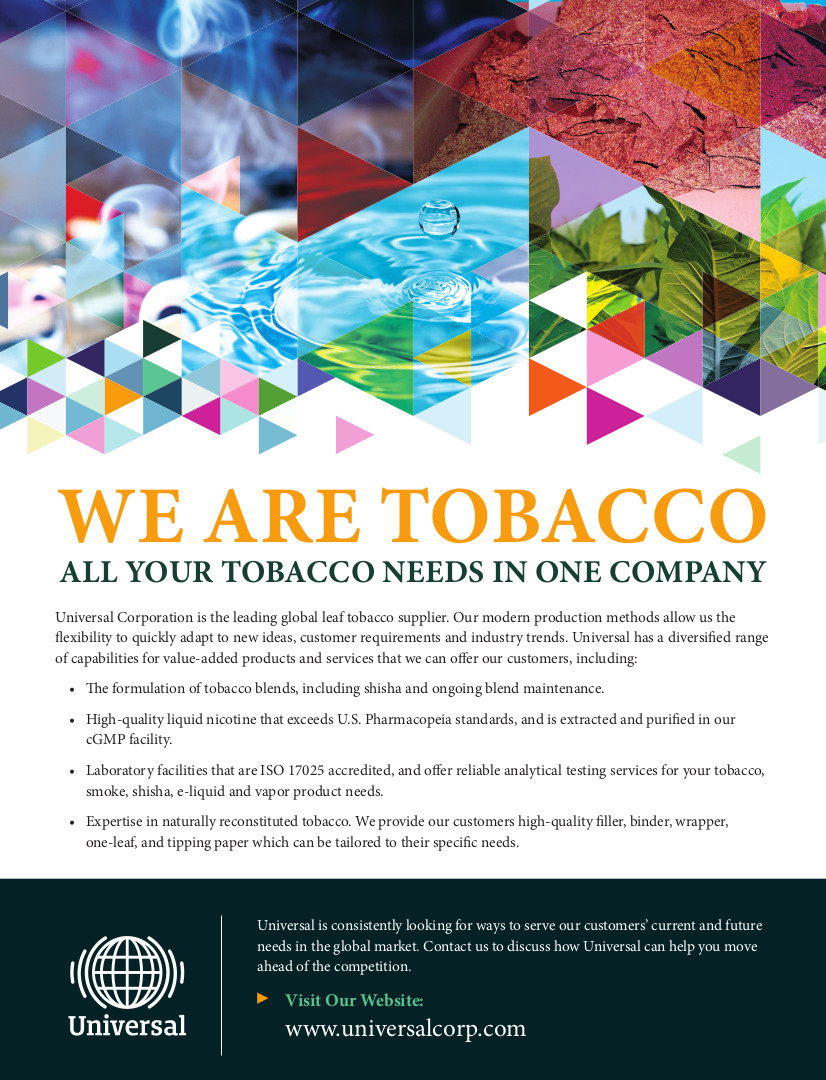Committed to Science
- Harm Reduction Print Edition Science
- January 1, 2023
- 0
- 15 minutes read

David O’Reilly

David O’Reilly, director of scientific research at BAT, shares his views on the roles of science and nicotine in tobacco harm reduction.
TR Staff Report
Science is instrumental as the tobacco industry transitions from combustible products to less risky smoking alternatives. Tobacco Reporter spoke with BAT’s director of scientific research, David O’Reilly, about the roles of science and nicotine in tobacco harm reduction.
Tobacco Reporter: You have been with BAT since 1991. Could you please compare the role of BAT’s science department at the time when there were only combustible cigarettes to the role it plays today?
David O’Reilly: BAT has a long history of conducting scientific research and has had an R&D facility in the U.K. for over 60 years. Throughout this period, we have seen the science significantly change.
Originally, the majority of R&D we conducted was focused on cigarettes and tobacco plant science, but the more we learned about combustion and the harm that burning tobacco causes, the more we shifted our efforts to exploring new ways to provide consumers with less risky alternative products.
Initially, our focus was on reduced-toxicant cigarettes, but, utilizing the growing body of evidence and the Institute of Medicine report that highlighted the negative impact of combustion, we shifted our activities to the development of noncombustible products.
This is now where the majority of our R&D efforts are focused: generating new evidence to support our new category products but also developing new or improved products.
To ensure that we are using the latest scientific thinking and cutting-edge techniques, we have increased our investment in science and expanded the number of scientists within BAT. We have recruited people from a broad range of backgrounds, such as genetics, neuroscience and data sciences.
With so much focus on the development of reduced-risk products (RRPs), does BAT still conduct research on combustible cigarettes?
Our primary focus within R&D is our new category products, as we know that consumer preferences continuously evolve, but also that science and innovation continue to change at pace. However, we do undertake some R&D on our combustible products. This is essential to ensure that they are produced to high quality and manufacturing standards.
What are your thoughts on very low-nicotine cigarettes with regard to their role in tobacco harm reduction?
Our belief is that tobacco harm reduction is the best way forward to reduce the health impacts of smoking. The evidence shows that most of the harm from cigarettes is caused by combustion and the burning of tobacco, not by the nicotine.
In fact, nicotine plays an important role in tobacco harm reduction. Since it is one of the reasons why people smoke, nicotine’s presence in products that, though not risk-free and addictive due to the presence of nicotine, are designed to be reduced risk1 compared to cigarettes. These products can help adult smokers to switch instead of continuing to smoke.
As Professor Michael Russell said in his 1976 pivotal paper, “People smoke for nicotine, but they die from the tar,”2 and we know if you take the nicotine away or offer very low amounts, consumers may not be satisfied and revert back to cigarettes rather than switching completely to a reduced-risk alternative that is backed by scientific research, such as vaping.
In RRP development, one of the most pressing challenges is youth initiation. To what extent can innovation help prevent underage consumption? Will it be necessary to sacrifice all nontobacco vaping flavors to achieve this goal?
We are clear that our products are for adult consumers only and that youth should never use any nicotine products, be it cigarettes or vaping products.
Our products are sold to adult consumers via reputable retailers that verify the age of consumers before sale and follow our youth access prevention standards, which include prominent 18-plus labels on the front of all packaging and on all communications.
This is in addition to robust age verification on our own e-commerce channels, our youth access prevention training and certification for retailers and our “iCommit” training for employees.
It is worth highlighting that alternative products need to be satisfying to prevent adult consumers from going back to cigarettes, and research has shown that flavors play an important role in encouraging adult smokers who would otherwise continue to smoke to switch to better alternatives. However, a priority for BAT is ensuring that our flavors and device colors are designed to appeal to adult consumers, not youth.
In order to switch away from combustibles, consumers need to like the alternative, less hazardous product. What still needs to be done to improve nicotine delivery and consumer satisfaction? Can you please give an example of how you improved one of your next-generation products in this respect?
When we develop any new product, we think holistically about the consumer experience, and we use science and consumer insights to guide our development programs and deliver products that consumers want and find satisfying. For example, when we think about a product, we think about many aspects, including the design, the feel, the power of the battery, ingredients of the liquids, taste, etc. BAT was one of the first companies to use nicotine salts, as we knew that consumer satisfaction is important to make vaping more acceptable to cigarette smokers. This is just one example of how science and consumer insights combine to enhance our products.
For tobacco harm reduction to succeed, product must be affordable, especially to customers in the low-income and middle-income countries where many of the world’s smokers reside. What solutions in addition to nicotine pouches are you researching in this regard?
Our purpose is to build “A Better Tomorrow” by reducing the health impact of our business. We are doing this by developing a wide choice of alternative products for adult consumers who would otherwise continue to smoke, tailored to meet their evolving preferences.
Two key components of every innovation program we undertake are sustainability and affordability. It is important that these aspects are considered from the outset and at every step of the way so that we deliver a product that consumers want. We continue to launch these in markets across the globe, and our aim is to switch 50 million consumers to our noncombustible products by 2030.
Sustainability is increasingly important. BAT has introduced a recycling campaign for its electronic nicotine-delivery devices and has begun replacing plastic elements of vapor products with pulp-based alternatives. However, vaporizers contain circuit boards, which in turn contain plastics and heavy metals, and they also use lithium-ion batteries. How is BAT tackling this issue?
Every product developed has sustainability as a key component of the development plan, and we are committed to carbon neutrality across our operations by 2030. In May 2021, Vuse became the first global carbon neutral vape brand due to our ongoing efforts, notably by offsetting its carbon impact.3
Also, in many markets where Vuse is available, there is a takeback scheme in place, which allows consumers to return products for responsible disposal.
As part of our ongoing Vuse “Cut the Wrap” initiative, Vuse Go packaging has no external plastic poly wrap. The initiative, which is our commitment to reduce single-use plastics in our packaging, has already saved approximately 250 tons of plastic, the equivalent to more than 10 million plastic bottles.4
Misconceptions about the relative risks of RRPs and misconceptions about the nature of nicotine also present major challenges to harm reduction. An increasing number of U.S. adult consumers believe that vaping is as hazardous or even more hazardous than smoking, for example, and there are also misperceptions in the scientific and medical world. Such misunderstandings are often fueled by flawed studies. What can the industry do to address this problem without being accused of lobbying and in an environment where many are skeptical about tobacco industry-funded research?
At BAT, we think that the solution cannot be delivered by industry alone. To the contrary, BAT needs to work together with the wider scientific community and other key opinion leaders to create a system that is clear about the harm caused by smoking yet recognizes, holistically and consistently, where real public health gains can be made. A system that encourages adult consumer choice. We want a “whole-of-society approach”—as referenced by the United Nations—to this important public health issue.
There is also a need for the ongoing generation of robust scientific evidence. BAT continues to invest in scientific studies and openly share the results to help build the evidence base that supports alternative tobacco and nicotine products and their potential role in tobacco harm reduction.
At BAT, we believe that adult consumers should have access to information that enhances their understanding and allows them to make informed choices based on the best available evidence.
The concept of harm reduction has been widely accepted in fields such as substance abuse. Why does it face so much resistance when applied to tobacco, and how can this be overcome?
Firstly, it is important to recognize that there are some governments, such as the U.S., U.K., Sweden and New Zealand, who have adopted progressive public health policies that reflect the growing weight of evidence that supports the role of alternative tobacco and nicotine products in providing less risky alternatives to those who would otherwise continue to smoke. In these countries, although not all at the same stage, we see the continued decline in smoking rates and progress toward becoming smoke-free (under 5 percent of the population).
In other countries, many of whom have adopted policies that do not differentiate between cigarettes and alternative products, we see little or even a reversal in progress. Often the reason for such an approach is the “precautionary principle.” Essentially, in the absence of epidemiological data about alternative products, governments will not recommend them.
However, we believe, based on the already available evidence about alternative products and providing a complete switch, that these are reduced risk1 compared to cigarettes. This is a view reflected through the work of independent organizations, such as Public Health England, who determined that based on current knowledge, vaping is at least 95 percent less harmful than smoking.5 However, it is important to note that these alternative products are not risk-free and contain nicotine, an addictive substance.
BAT has started to build an innovation hub in Trieste, Italy. What role will this hub play within the company’s global strategy for innovation and sustainability? What does this mean for your R&D site in Southampton?
The Trieste innovation hub will host a range of facilities, including a new manufacturing site for BAT’s New Category products, a digital boutique, innovation lab and Centre of Excellence for digital transformation and digital marketing. These activities, alongside the activities undertaken at our other R&D and innovation sites, complement and build upon the research and development work undertaken in Southampton, which is focused on generating the science needed to substantiate our products whilst ensuring they are produced to high standards.
What role should tobacco harm reduction play nowadays?
Tobacco harm reduction is one of the most important public health strategies. Science plays a critical role in delivering the alternative products that enable it but also allows us to measure the impact and outcomes of switching completely from cigarettes.
Work by scientific experts, using advanced computing and modeling, has shown us the potential for substantial life year gains and premature deaths caused by smoking-related diseases averted than can be delivered by switching smokers to vapor products.6 The longer these alternative products are on the market, the more real-world data we will be able to collect, which will be very powerful and reinforce our belief about the critical role they play in tobacco harm reduction and building “A Better Tomorrow.”
1Based on the weight of evidence and assuming a complete switch from cigarette smoking. These products are not risk-free and are addictive.
2 Russell MJ. Low-tar medium nicotine cigarettes: a new approach to safer smoking. BMJ 1976;1:1430–3.
3 Based on Vuse Go, [Vuse Go Max], Vuse ePod, ePen, eTankmini, Alto devices and consumables internal sales forecast (calculated March 2022) for 12 months starting from April 2022. Vuse will have reduced its carbon emissions by circa 55 percent (as of March 2023) through its internal sustainability initiatives since launched in 2019 and has now offset the remaining circa 45 percent.
4 Plastic saving was calculated from 2020 global sales volumes and 2021 forecasted sales, and the plastic bottles comparison was based on a 22.9 g bottle weight, representative weight of 500 mL commercially available soft drink bottles (May 2020).
5 Evidence review of e-cigarettes and heated-tobacco products 2018 (publishing.service.gov.uk).
6 Potential deaths averted in the U.S. by replacing cigarettes with e-cigarettes – PubMed (nih.gov).



